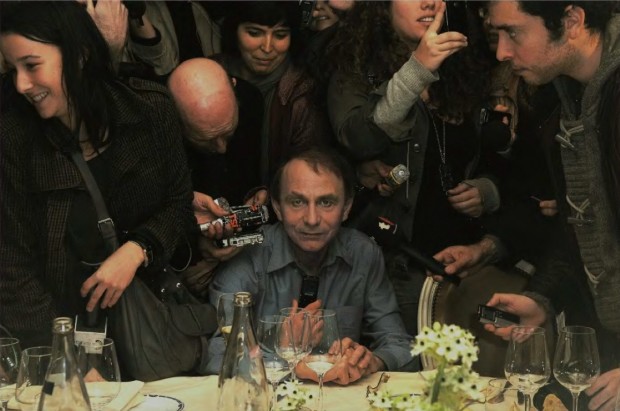An iconographic and text archive related to communication, technology and art.
☛ The New Yorker: accompanying photo for James Woods’ review of The Map and the Territory by Michel Houellebecq, January 23, 2011, p. 79. Photo by WireImage contributor Dominique Charriau. © WireImage.
The original caption by WireImage reads as follows:
Michel Houellebecq gives a press conference after he received the 2010 Prix Goncourt at Restaurant Drouant on November 8, 2010 in Paris, France.
I find it to be quite a startling portrait. For an instant, Houellebecq seems to be impervious to the surrounding agitation. He looks directly at the camera and display a somehow enigmatic, unsettling smile. The all scene is dimly lit and is reminiscent of the use of chiaroscuro in painting.
In fact, it really looks like a painting to me (a painting by Caravaggio: that would fit with the use of chiaroscuro). Furthermore, I can’t help but to think the photograph bears some resemblance with Christian art. Houellebecq is represented as a respected figure who has some important news to share. He is surrounded by media representatives ―modern apostles― who are willing to transmit his message all over the world.
With one important discrepancy: in the Christian tradition, the Messiah brings good news (literally euangelion, “good news”). In contrast, Houellebecq’s novels usually reveal an uncanny and worrying reality. Is he simply the bearer of difficult and hard news: a disangelist? Or does his prose supposed to help us discover and engage in a more autonomous path through modernity? Perhaps the reading of Sloterdijk’s essay La compétition des bonnes nouvelles could help clarifies some of those ideas (originally published in 2000 as Über die Verbesserung der guten Nachricht. Nietzsches fünftes Evangelium; it has yet to be translated into English at the time of this writing). It certainly wouldn’t be the first time parallels are found between Nietzsche’s writings and Houellebecq novels.
- By Philippe Theophanidis
- on
- ― Published in Art, Communication, Literature, Photography
- Tagged: Apostle, event, Goncourt, Gospel, Houellebecq, media, message, Messiah, modernity, news

